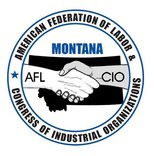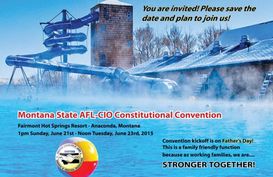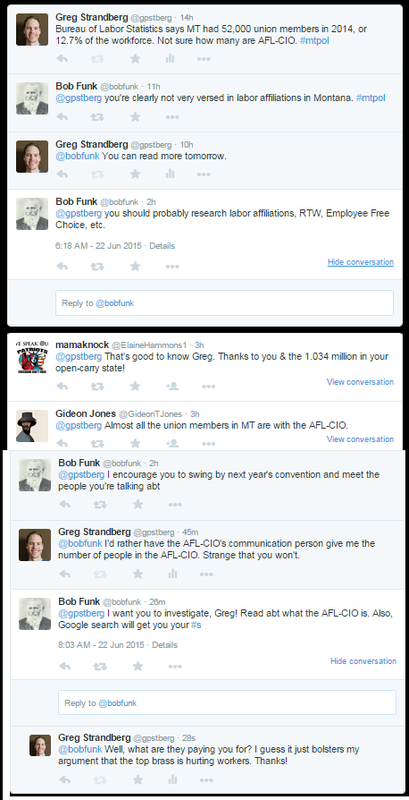
The Montana AFL-CIO is the state chapter of the AFL-CIO, which is the American Federation of Labor and the Congress for Industrial Organizations. The AFL started in 1886.
In 1934 and 1935 American workers felt they weren’t being represented by the largest of the nation’s unions, the American Federation of Labor, and began to form smaller unions. The AFL saw the writing on the wall and combined these fledgling unions into the Committee for Industrial Organization, or CIO.
It was in the fall of 1937 that the AFL “expelled” the CIO. The CIO had 4 million members at the time and changed its name to the Congress for Industrial Organizations. It wasn’t until 1955 that the two organizations merged again.
Beginning in 2003, things started to go south for the AFL-CIO. Leadership began to argue over the direction the union should take, and this resulted in a split and the formation of the New Unity Partnership (NUP).
By 2005 the New Unity Partnership had morphed into the Change to Win Federation (CtW). They took their 5.4 million members and broke off from the AFL-CIO, taking some of the largest unions in the organization with them. These included the Teamsters and the United Food and Commercial Workers International Union. The Service Employees International Union left as well, calling leadership “pale, male, and stale.” By early 2006 the United Farm Workers and UNITE HERE, a union of service industry workers, also broke off. That summer the Laborers’ International Union of North America joined them.
Why was there so much turmoil with the AFL-CIO in the mid-2000s?
Most of the problems can be traced to incoming AFL-CIO President John Sweeney, who took over in the 90s. No one much liked his leadership, and by 2005 the unions started to bolt.
Things were bad. The AFL-CIO lost a ton of members and a ton of money. But the other unions weren’t doing that well either. Beginning in 2009 and 2010, many started to come back. Still, the damage was done, mistrust had been sown, and many felt that things would never be the same again.
I’m not so sure the convention will be able to help many Montana workers, to be completely honest. In fact, I don’t think it will do anything…unless you count making the union brass feel like they’re doing something. They’re not, but we’ll get to that a little later.
The AFL-CIO has 11.6 million members today and $93 million in assets to play around with. They have a total of 459 employees in the organization, with at least 3 to 5 in Montana (I can’t tell with all the board members, and honestly, I’m not sure what some positions even do).
In 2005 before the split the AFL-CIO had 13.7 million members. That dropped to 9.8 million in 2006.
The organization is spending a lot more despite this substantial drop in both members and earnings. In 2002 they spent $76 million but in 2013 that was up to $192 million. Income has kept pace with that, though where that income is coming from I’m not sure. Well, hold on…it’s coming from workers.
In 2002 the AFL-CIO was getting $6 per member but in 2013 that was up to $17. What are members paying nearly 3 times as much for?
Well, according to the Membership Benefits section of their website, members can get “credit cards, scholarships, mortgages, legal services and more.”
Wow, just what I always wanted. Sorry if I sound a little disrespectful, but show me the money. Thankfully, the AFL-CIO does. Non-union workers make about $763 a week while unionized workers take home $970 a week. Sounds like a lot, but it’s not.
There are only 14.6 million Americans in unions anymore, or just 11.1% of the workforce, according to the 2014 Bureau of Labor Statistics. In 1983, the first year of statistics, there were 17.7 million union members, or 20.1% of the workforce. In the 1950s it was nearly 30% of the workforce. Now compare that to Canada where 26% of workers are unionized, or Germany where 40% are, or even Finland, which has 70% of its workers unionized.
Private sector workers are unionized just 6.6% of the time, compared to the 35.7% that public workers are unionized. There are 11.7% of men in unions while just 10.5% of women are in one.

So what do Montana union numbers look like?
We know the state has 52,000 unionized workers. In 2014 Montana had 414,000 workers and 52,000 were in unions, or 12.7%. If you want to look at those represented by unions but not members, it goes up to 57,000, or 13.8% of the workforce.
How does that break down?
- MEA-MFT, the teacher’s union, has 18,000 members;
- The Teamsters have two chapters in Montana, the Butte Teamsters and the Billings Teamsters. There are 358 Teamster chapters in the US, with 1.4 million members. For the most part, this union falls under the purview of the AFL-CIO.
- The United Food and Commercial Workers International Union has more than 1.3 million members in America, primarily grocery store workers. Why aren’t they in Montana?
- The American Federation of State, County and Municipal Employees has 1.6 million members in the country. I’m not sure how many they have in Montana, but they’re heavily affiliated with the AFL-CIO in the state.
That’s about all I found. So the Montana AFL-CIO could have 34,000 members, although I don’t think it’s that high. Even if it was, that would only be 8.2% of Montana’s workforce that this organization represents.
So when I ask the question, can the Montana AFL-CIO convention help you at all, I think we know the answer is no.
You’re not in that union, most likely, just like most Montana workers aren’t. Most Montana workers aren’t in any unions, and I’m not sure that’s seen as a problem. I think it is – I’ve been saying for months that we need our 100,000+ strong tourism industry workforce unionized, both because it’ll put more money into our local communities and it’ll create a very powerful voting bloc that favors Democrats.
As usual, no one is interested in hearing my ideas.
I just don’t feel that Montana wants anymore unions, and I feel that Montana’s current unions share that sentiment. That’s my opinion, and since I see no action on the part of Montana unions to see more workers unionized, or different economic sectors unionized, I have to think that.
But can you blame them? Most union jobs are in “education, training, and library occupations and protective service occupations,” according to the 2014 Bureau of Labor Statistics Report (PDF), and this makes up 35.3% of all the union workers. “Sales and related occupations,” the kind of jobs that are growing swiftly in Montana, make up just 3.1% of unionized workers.
Most union workers are old, with 28% between the ages of 45 and 64. So that reflects Montana, but not the kind of jobs we’re growing, which are service industry jobs. Just 21.6% of Montana union workers are between the ages of 25 and 44.
- Just 13.6% of healthcare workers are unionized, and 11.5% of service occupations.
- Only 4.7% of food preparation workers are unionized, and just 7.2% of sales workers.
- There are 2.6% of financial service industry workers unionized and 3.2% of the leisure and hospitality industry.
These are the industries we have in Montana, but they’re not unionized. Why?
Of course, fighting to represent workers like fast food workers or service industry workers or retail workers isn’t worth the time and effort. On top of it, it very well could take away from the immense amount of profits union leaders enjoy. We see those profits at work over these three days at the hot springs.
And let’s not forget that split in 2005. Union brass is deathly afraid something like that might happen again, especially if they start focusing on younger workers at the ‘expense’ of their older workers. And let’s not even get into the levels of animosity felt by non-unionized workers toward those that are ‘fortunate’ enough to be in unions. Most of us Montana workers aren’t in the right industries, however, so we’re useless to the AFL-CIO.
It’s no surprise that unions stopped working for workers in Montana. I profiled long ago how nincompoop Eric Feaver makes $125,000 working for MEA-MFT, the teacher’s union in the state. I find that reprehensible, but most just look the other way. Well, when your boss will fire you for speaking out against stuff like that, what can you do?
The AFL-CIO is the same way – if you say anything against a union, you’re their enemy, not their friend. They’ll use that argument each time executive pay is brought up, all the way until the only members of the union are executives. That won’t work really well, because they’ll balk at paying themselves, unlike the workers, who never balk at what the top brass is paid. Al Ekblad is the president of the Montana AFL-CIO. I’m not sure what he’s paid, but it’s probably a lot.
But again, if you question this, you’re through. It’s a shame what unions have become in this country – facades, fakes, and relics of a bygone day when workers could actually expect to get ahead. Those days are gone, and far from crying out against it, the union bosses try to take as much as they can for themselves, the worker be damned.
There’s a total of 189,217 union officers and staff members in America, and collectively they make $1.14 billion in compensation each year. Union employees, on the other hand, make $2.49 billion each year. That comes out to $170.55 for each union worker and $6,024.83 for each union official.
Can the Montana AFL-CIO convention help you at all? Well, are you a top official? Then it will help you, both by wining and dining you and congratulating you on a job well done.
If you’re a Montana worker, however, the convention will do nothing for you, nothing at all.
Notes
Boardman, Fon W. Jr. The Thirties: American and the Great Depression. Henry Z. Walck, Inc.: New York, 1967. p 91-2.
Franklin, Stephen. “A Brief History of Labor Unsolidarity: AFL-CIO and Change to Win.” In These Times. Web. 26 August 2010. Retrieved 22 June 2015. http://inthesetimes.com/working/entry/6369/a_brief_history_of_labor_unsolidarity
Kutalik, Chris. “What Does the AFL-CIO Split Mean?” Labor Notes. Web. 31 August 2005. Retrieved 22 June 2015. http://www.labornotes.org/2005/08/what-does-afl-cio-split-mean


